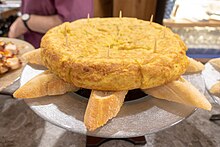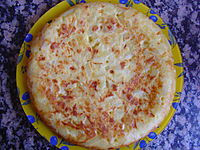Spanish omelette
 Spanish omelette in a pinchos bar in San Sebastián | |
| Alternative names | Tortilla de patatas Tortilla de papas Tortilla española Spanish tortilla Potato omelete |
|---|---|
| Course | Tapas, Appetizer or Main course |
| Place of origin | |
| Serving temperature | Either warm or room temperature |
| Main ingredients | Egg and potatoes |
| Variations | May optionally include onion |
Spanish omelette[1] or Spanish tortilla[2] is a traditional dish from Spain and one of the signature dishes in the Spanish cuisine. It is an omelette made with eggs and potatoes, optionally including onion. It is often served at room temperature as a tapa.
It is commonly known in Spanish-speaking countries as tortilla de patatas, tortilla de papas or tortilla española.
History[]

The first reference to the tortilla in Spanish is found in a Navarrese document, as an anonymous "Mousehole's memorial" addressed to the Navarra region's court in 1817. It explains the sparse conditions of Navarre's farmers in contrast with those in Pamplona (the capital) and la Ribera (in southern Navarre). After listing the sparse food eaten by highlanders, the next quote follows: "…two to three eggs in tortilla for 5 or 6 [people] as our women do know how to make it big and thick with fewer eggs, mixing potatoes, breadcrumbs or whatever."[3]
According to legend, during the siege of Bilbao, Carlist general Tomás de Zumalacárregui invented the "tortilla de patatas" as an easy, fast and nutritious dish to satisfy the scarcities of the Carlist army. Although it remains unknown whether this is true, it appears the tortilla started to spread during the early Carlist Wars.[4]
Another tale is that the recipe was learnt by Spanish prisoners captured after the Battle of Montes Claros during the Portuguese Restoration War in 1665.[5] After the Portuguese victory, more than 6,000 Spanish soldiers were kept in captivity for 3 years until the 1668 Treaty of Lisbon was signed. Upon their release, these prisoners brought part of the culture of Alentejo to Spain, including many recipes, which featured a potato egg pie that evolved into the modern version of "tortilla".[6]
Nomenclature[]
The word tortilla, in European Spanish as well as in some variants of Latin American Spanish, means omelette.[7][8] As such, a potato omelette is a tortilla de patatas or papas.[9][10]
As the dish has gained international popularity, and perhaps to avoid being confused with the thin flatbread made out of wheat or maize popular in parts of Latin America such as Mexico and Central America, the española or Spanish naming gained traction. As such, Spanish omelette[11][12] or Spanish tortilla[13][14] are its common names in English, while tortilla española[8][12][15][16] is formally accepted name even within the peninsula. In Spain, omelette (made of beaten eggs fried with olive oil) is conversely known as tortilla francesa (lit. 'French omelette').[17]
Tortilla is the diminutive form of torta, meaning 'small pancake'.[7][8]
Consumption and traditional recipe[]
The Spanish omelette is one of the most widely available dishes in Spain, also prepared in some Spanish-speaking countries.
The two main options are either with or without onion in it, with consumers almost always having a preference. The addition of onion is often controversial, and sometimes may be related to the tenderness of the local varieties of potato. The indication of whether a tortilla includes onion or not is expected from restaurateurs, and industrial producers market both options.
The most common procedure to cook a Spanish omelette is as follows:
- The potatoes, ideally a starchy variety, are cut into thin slices or small dice.
- They are then seasoned and sautéed in vegetable oil, traditionally olive oil, with sliced onions being added at this stage if used. These ingredients are stirred at a moderate temperature until they are soft but not brown.
- The potatoes (and onions, if included) are then removed, drained, and mixed with whisked eggs.
- This mixture is then returned to the pan and slowly cooked, turning the omelette to cook both sides.[1][19]
- Once the eggs are cooked on one side, a plate is placed over the mixture so the pan can be inverted.
- The mixture is then slipped back into the pan to cook the other side.[20]
The omelette may be eaten hot, at room temperature, or cold; it is commonly served as a tapa. As a tapa, it may be cut into bite-size pieces and served on cocktail sticks; a large tortilla can be cut into triangular portions (pincho de tortilla) to be eaten as a finger food.
A very large tortilla was made by 12 chefs in Vitoria, Spain, in 2014, who claimed it to be a record. It was 5 m (16 ft) in diameter, and used 1.6 tons of potatoes, 16,000 eggs, 150 l (33 imp gal; 40 US gal) of oil, 26 kg (57 lb) of onions, and 15 kg (33 lb) of salt[dubious ].

Tortilla de Betanzos is amongst the most popular Spanish omelettes, characterised by being softer or "runny"
Asturian tortiella de pataques, characterised by its thickness[citation needed]

Tortilla de patatas with a less-fried finish
See also[]
| Wikibooks Cookbook has a recipe/module on |
- Paella – Valencian rice dish
- Jamón – Type of dry-cured ham from Spain
- Tapas – Appetizer or snack in Spanish cuisine
- Spanish cuisine – Culinary traditions of Spain
- Tortilla – Thin, flat unleavened bread originally made from corn, a Mexican flat bread
- Frittata – Egg-based Italian dish
- Kuku
- Tunisian tajine – Berber dish
References[]
- ^ Jump up to: a b "Real Spanish omelette". Bbcgoodfood.com. Retrieved 10 January 2016.
- ^ "Spanish Tortilla". Food Network. Retrieved 3 June 2019.
- ^ (Spanish) Los "memoriales de ratonera" eran escritos que cualquier ciudadano navarro podía depositar en un buzón ("ratonera") cuando se reunían las Cortes; véase José María Iribarren: "El comer, el vestir y la vida de los navarros de 1817, a través de un 'memorial de ratonera'", en: Príncipe de Viana 17, núm. 65 (1956), pp. 473-486.
- ^ Jack, Albert (2010). What Caesar Did For My Salad: The Secret Meanings of our Favourite Dishes. Penguin. p. 368. ISBN 9780141929927
- ^ Tuell, Marcus (1952). History of War in the Iberian Peninsula. Baltimore: William & Wilkins Publishing House. pp. 242–244
- ^ White, L. (2007). Strategic Geography and the Spanish Habsburg Monarchy's Failure to Recover Portugal, 1640-1668. The Journal of Military History, 71(2), 373-409. JSTOR 413827
- ^ Jump up to: a b "Tortilla | Definition of Tortilla by Lexico". Lexico Dictionaries | English. Retrieved 2019-11-02.
- ^ Jump up to: a b c ASALE, RAE-. "tortilla". «Diccionario de la lengua española» - Edición del Tricentenario (in Spanish). Retrieved 2019-11-02.
- ^ ASALE, RAE-. "patata". «Diccionario de la lengua española» - Edición del Tricentenario (in Spanish). Retrieved 2019-11-02.
- ^ ASALE, RAE-. "papa¹; papa²; papa³". «Diccionario de la lengua española» - Edición del Tricentenario (in Spanish). Retrieved 2019-11-02.
- ^ Cloake, Felicity (2010-07-29). "How to make a perfect Spanish omelette". The Guardian. ISSN 0261-3077. Retrieved 2019-11-02.
- ^ Jump up to: a b "Tortilla Española | Definition of Tortilla Española by Lexico". Lexico Dictionaries | English. Retrieved 2019-11-02.
- ^ Bittman, Mark. "Spanish Tortilla Recipe". NYT Cooking. Retrieved 2019-11-02.
- ^ JamieOliver.com. "Spanish tortilla recipe | Jamie Oliver egg recipes". Jamie Oliver. Retrieved 2019-11-02.
- ^ "Tortilla Española - Cultura española". www.enforex.com. Retrieved 2019-11-02.
- ^ Vigo, Faro de. "La auténtica tortilla española". ocio.farodevigo.es. Retrieved 2019-11-02.
- ^ Moraleda, Alba (24 December 2020). "Por qué la tortilla francesa es mejor que la española para tu salud". El Español.
- ^ 20Minutos, "Poco hecha y sin cebolla, ¿es la tortilla de Betanzos la mejor del mundo?" - 5 octubre 2020
- ^ "Trucos para Preparar una Deliciosa Tortilla de Patata" [Tricks for making a delicious potato tortilla]. Palacios.es (in Spanish). Retrieved 10 January 2016. A typical recipe
- ^ Cloake, Felicity (2010-07-29). "How to make a perfect Spanish omelette". the Guardian. Retrieved 2018-07-06.
External links[]
| Wikimedia Commons has media related to Spanish omelette. |
- Spanish cuisine
- Egg dishes
- Omelettes
- Potato dishes
- National dishes
- Tapas
- Food combinations



